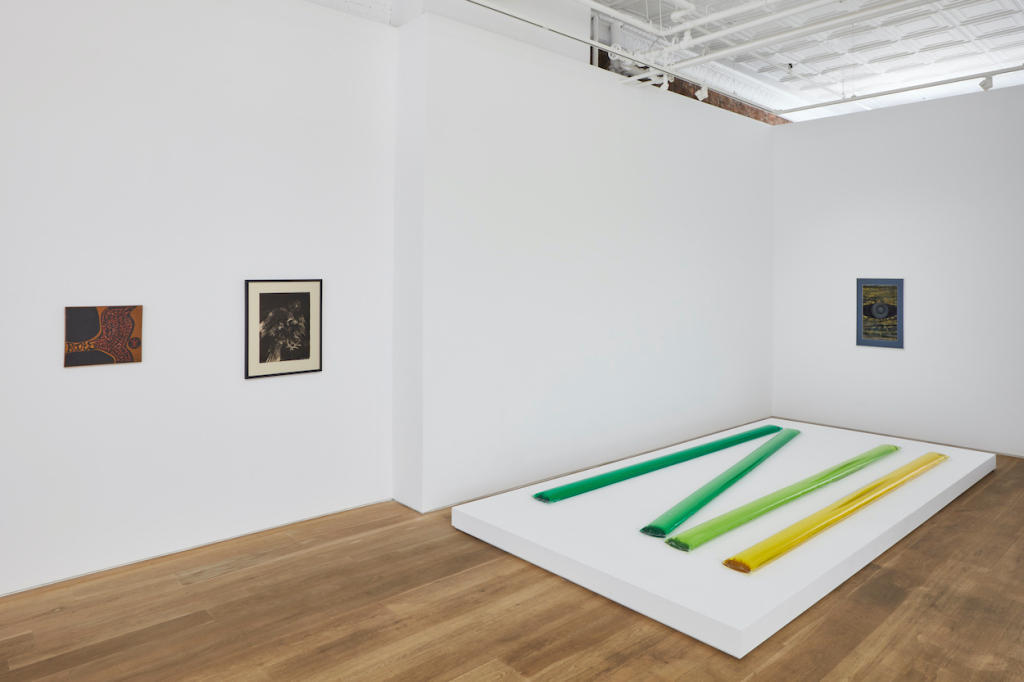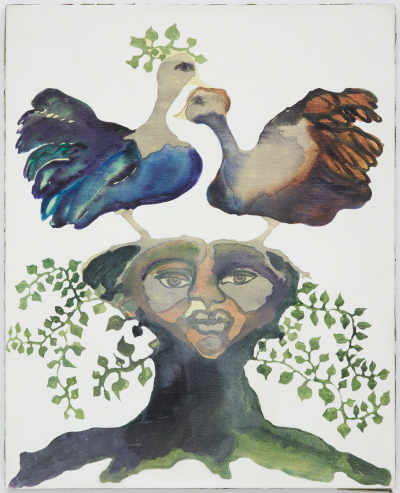 View of “You’ve Come a Long Way, Baby: The Sapphire Show,” 2021, at Ortuzar Projects, showing Senga Nengudi, Water Composition V, 1969–70/2018.
View of “You’ve Come a Long Way, Baby: The Sapphire Show,” 2021, at Ortuzar Projects, showing Senga Nengudi, Water Composition V, 1969–70/2018.
Much of the material for an alternative art history exists not in pristine archives but in fragments of ephemera and distant memories; piecing these works and events into new narratives requires a creative approach. One such reconstruction is “You’ve Come a Long Way, Baby: The Sapphire Show,” on view until July 31 at Ortuzar Projects in New York. The exhibition reimagines the “Sapphire Show,” which opened on the Independence Day holiday weekend in 1970 at artist Suzanne Jackson’s experimental arts venue, Gallery 32, in Los Angeles, as a reaction to a lack of representation of Black women in the local art scene.
While reuniting the original participants—Gloria Bohanon, Yvonne Cole Meo, Eileen Nelson, Senga Nengudi, Betye Saar, and Jackson—this iteration brings together pieces from that era with more recent projects and takes place on the opposite coast. These conditions invite a question: How can one re-present an event from fifty years before in a way that acknowledges shifts and changes in the artists’ lives and oeuvres since? Starting with its title, “You’ve Come a Long, Baby”—once a Virginia Slims advertising slogan courting feminists, here a fitting tribute—the show delineates such developments, presenting an eclectic assortment of prints, paintings, photographs, sculptures, and collages that add up to an intimate, hand-picked re-envisioning of the first “Sapphire Show,” one more invested in drawing attention to its artists than replicating its checklist.
Before walking into the main space, visitors encounter two vitrines. In one, photographs of Jackson and others at Gallery 32 and announcements for other exhibitions at the space set the stage for the venue that made the first “Sapphire Show” possible. In the other, a program flyer and a press photo nod to other shows that included some of the six artists, and sit beside materials that point to their wider context—such as an article written by Meo on the work of Houston Conwill in an issue of Black Art: An International Quarterly and an out-of-print artist anthology titled Gumbo Ya Ya that features entries on almost every “Sapphire Show” participant. The only archival piece directly tied to the show at hand is an original announcement, featuring black-and-white photographs of the participants.
 Suzanne Jackson, The American Sampler, 1972, acrylic wash on canvas, 48 by ¾ by 39 in. Photo: Timothy Doyon. Courtesy the artist and Ortuzar Projects, New York.
Suzanne Jackson, The American Sampler, 1972, acrylic wash on canvas, 48 by ¾ by 39 in. Photo: Timothy Doyon. Courtesy the artist and Ortuzar Projects, New York.
From this introduction, assemblage becomes a motif in the exhibition. Many of the works on view are true assemblages, like Eileen Nelson’s Wood City (ca. 1970s)—a geometric composition made of thick branch segments jostling with wood strips, shards, and shims standing on end—and one of Betye Saar’s shadow boxes featuring Aunt Jemima figurines, which led the way in recontextualizing the problematic image. Assemblage can also describe how the works are displayed, without deference to chronology, medium, or subject. This leads to some unexpected encounters. Water Composition V (1969–70/2018), one of Nengudi’s lesser-known “Water Composition” works, beckons visitors into the main gallery space: on a low platform lie four clear, roughly twelve-foot-long flattened vinyl tubes filled with colorful liquid; they resemble oversize freeze pops. Visitors familiar with Nengudi’s soft, abstract installations made from pantyhose and sand might note that this piece is still reminiscent of the body, yet its emphatic reference to the inexpensive summertime treat makes it irreverent, casting it outside the more outwardly serious work in both Nengudi’s oeuvre and this exhibition. The other, smaller, untitled “Water Composition” (1969–70/2021), comprising connected triangular pouches, perches flaccidly on a pedestal in a far corner of the gallery. The juxtaposition of these works with darker and more enigmatic collage and mixed-medium works by Meo and Bohanon, respectively, demonstrates that although the six artists came together under the same rallying cry for the “Sapphire Show,” the timbres and strategies in their work are distinct. What ties the current exhibition together are the five works by Jackson, who represents the nexus of both shows, as the host of the original one and the sole artist among them represented by Ortuzar Projects. The wizened, somber face on a dark old tree in Jackson’s painting American Sampler (1972) is echoed in the expressionless but nonetheless beguiling silhouettes in Bohanon’s pieces.
At a time when institutions are slowly recognizing late-career Black women artists, and the market for their work is ascendant, “You’ve Come a Long Way, Baby” posits an alternative way of reintroducing such practitioners to the art world. It follows one of the less common paths to remembering these formative moments by celebrating rather than fretting over the gaps and openings in the archive and the artists’ memories. Reassembling these diverse practices illuminates new stories to be told, new constellations to be formed.
Source link : https://www.artnews.com/art-in-america/aia-reviews/youve-come-long-way-sapphire-show-ortuzar-projects-1234600415












